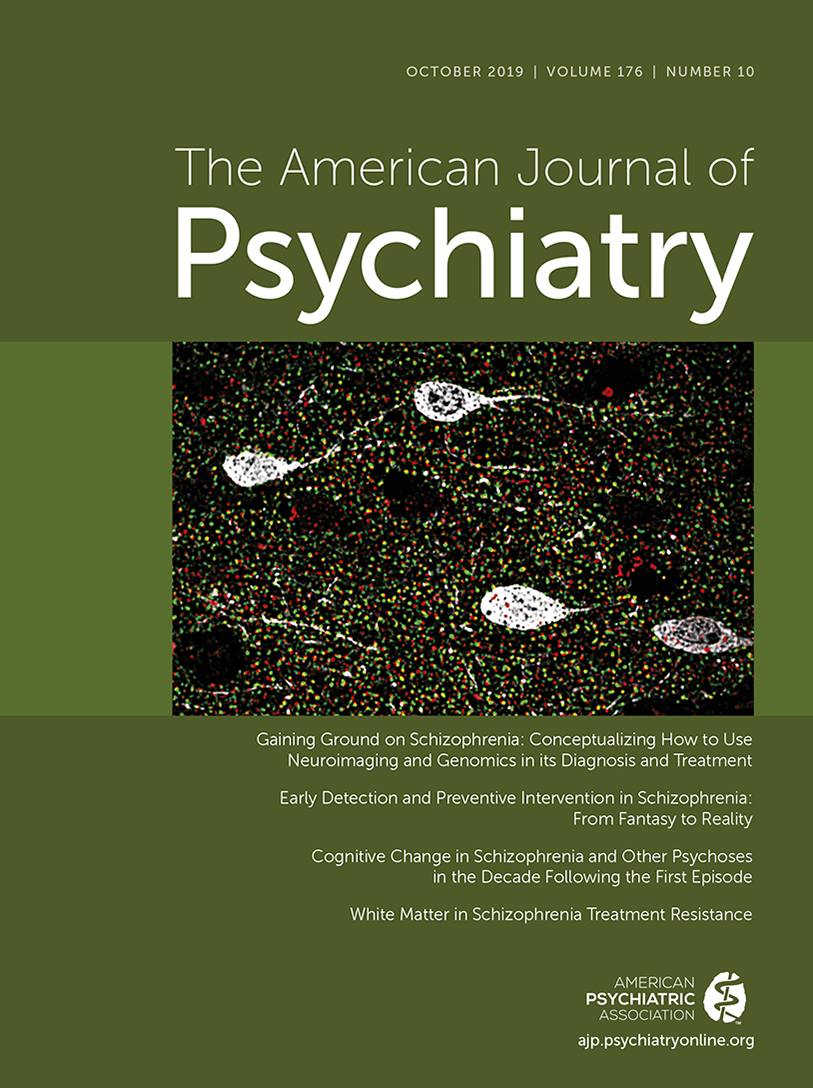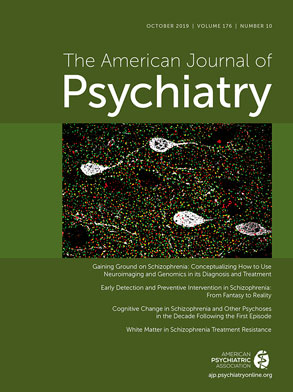In this issue, Tang et al. (
1) employ a combination of traditional and novel diffusion techniques to investigate microstructural changes in individuals identified as being at clinical high risk for schizophrenia. Studies in individuals at clinical high risk are powerful in that they have the potential to shed light on the mechanisms underlying the onset of early psychosis. Such studies may ultimately enable us to identify factors that predict conversion to a diagnosed psychotic disorder, and thus may offer the opportunity for early intervention for those most at risk. However, while existing work in this area has led to a greater understanding of the period leading up to onset, the often indirect or inferential nature of many neuroimaging measures limits our ability to understand the cellular basis of neural changes during this important period.
Diffusion-weighted neuroimaging techniques use variation in the diffusion patterns of water to infer details about the surrounding tissue. The diffusion tensor imaging (DTI) model is the most common diffusion approach, and fractional anisotropy (FA) is the measure most frequently used in DTI studies. In DTI, the pattern of water diffusion is characterized as an ellipse, with FA representing the ratio of the longest and shortest aspects of the ellipse. Higher FA (a longer, narrower ellipse) is considered to indicate higher white matter “integrity,” although it is frequently used as a proxy for myelination. However, FA has drawbacks, as it may reflect a number of different factors, including tract spacing, myelination, and tissue organization (
2). DTI studies using FA have led to valuable insights into schizophrenia and other neuropsychiatric disorders. However, the inferential nature of DTI measures, as well as the potential for FA to index factors other than myelination, have been a limiting factor in existing research.
Multishell diffusion imaging has made it possible to assess tissue microstructure at a more sophisticated level. Diffusion sequences can vary in the number of directions in which the gradients are applied, with more directions improving the estimation of the pattern of diffusion. Sequences can also differ in the strength and duration, or weighting, of the gradients, something that is summarized in the b-value metric. Standard sequences may have a combination of unweighted (b=0) and weighted (b=1000) acquisitions, and a multishell sequence has multiple b-values, such as the b=0, 200, 500, 1000, and 3000 collected by Tang et al. in the study reported in this issue. The authors employed free-water imaging, which uses multishell data to separately model water diffusion as two compartments: one consisting of unrestricted extracellular water, and one consisting of water with movement restricted by cellular structures and tissue membranes (
3). This modeling approach allows the estimation of changes that might occur extracellularly, such as inflammation and atrophy, and changes that would be considered intracellular, such as myelination differences. In the context of clinical high risk studies, such dissociations are of particular interest, as an alteration in either intra- or extracellular factors would be associated with different underlying mechanisms and thus different potential treatment pathways. In particular, although free water (FW) may be affected by a number of different tissue changes (
4)—including decreased numbers of cell bodies or dendrites—one of the motivations for free-water imaging is the exploration of inflammatory hypotheses of schizophrenia. Such hypotheses are based on a growing number of findings, including those from genetic studies implicating the major histocompatibility complex (
5), findings of disrupted cytokine activity in schizophrenia (
6), and findings of prenatal infection or inflammatory processes (
7).
There are a small but growing number of free-water imaging studies in psychosis, with somewhat mixed findings overall. Free-water imaging produces multiple indices, one being the FW extracellular measure and another being FA
T, a corrected FA measure that eliminates confounders from CSF or other free water and is more specific to white matter tissue than traditional FA. In first-episode patients, some investigations have found increased FW (consistent with heightened inflammation) in white matter (
4,
8) and gray matter (
4,
9), although some have found no evidence of increased FW in white matter (
9). Relatedly, efforts by some groups to examine FA
T in first-episode patients have shown changes in this metric as well (
4,
8,
10). In chronic patients, however, a number of studies have failed to find FW differences (
11–
13), although there is evidence that if individuals are still symptomatic, FW changes may be present (
14). Relevant to the Tang et al. sample, otherwise healthy individuals who hear voices show FA
T changes but not FW changes in multiple regions (
11). The authors interpret this pattern of previous results in the literature as indicating that there are inflammatory processes present in the first episode of psychosis or in actively psychotic individuals but that this acute inflammation may resolve over time, resulting in increased FW in first-episode but not chronic patients. By extending the existing free-water imaging studies to include participants at clinical high risk, the goal is to understand whether this inflammation precedes and potentially causes the onset of psychosis or whether it only emerges as a part of a fully symptomatic psychotic episode.
In the Tang et al. study, the authors propose that the measures available from free-water imaging represent distinct tissue alterations with distinct etiologies (
1), and specifically that differences in the FW extracellular measure are associated with an acute brain response to psychosis, whereas FA
T alterations arise from a preexisting neurodevelopmental anomaly, such as impaired myelin. Here, they assessed data from 50 clinical high risk and 50 control individuals (ages 14–32). They report three primary findings. First, they found significant differences between groups in FA and FA
T, but not FW, when looking at whole brain white matter. As standard FA measures average across both compartments, the authors interpret this pattern to mean that observed FA changes in youths at clinical high risk are driven by tissue-specific changes, such as myelination, rather than by excess free water. The authors then looked in more detail at regional differences across the white matter. FA and FA
T changes are shown in similar regions, in a number of long-range tracts that have been implicated in schizophrenia; there were no voxel-wise differences in FW. These findings are consistent with existing work showing white matter integrity differences as measured by FA in individuals at clinical high risk (
15), and they extend previous work to demonstrate that the FA differences persist when corrected for FW.
Second, the authors examined functional implications of decreases in FA
T, finding that individuals with lower FA
T at the time of scanning had also experienced the largest decreases in Global Assessment of Functioning Scale scores during the previous 12 months. Finally, they find that FA
T increases with age in control youths, consistent with expected adolescent myelination, but not in youths at clinical high risk. This age-related change was also detected for FA as well as two secondary measures. Radial diffusivity (RD), representing the shortest aspect of the ellipse in DTI, and axial diffusivity (AD), representing the longest, are believed to more specifically index myelination and axonal organization, respectively (
16). Here, axial diffusivity in tissue, corrected for free water (AD
T), and radial diffusivity in tissue (RD
T) showed group differences as well. However, no group differences were observed for FW. This failure to show an increase in measures of myelination across adolescence and early adulthood reflects a pattern that has been observed in young individuals diagnosed with psychosis as well as those at risk (
17).
These findings have a number of implications. In the year following the MRI assessment, clinical follow-up indicated that 11 of 50 individuals at clinical high risk converted to a psychotic disorder. This highlights one of the challenges of interpreting clinical high risk data, namely, that these individuals are at risk for, not diagnosed with, psychotic disorders. While some of them will go on to develop psychotic spectrum disorders, some will improve, and some may remain with symptoms at a subclinical level (
18). The authors hypothesize that the lack of FW findings in the clinical high risk state, in contrast to positive FW findings reported in first-episode patients (
4), indicate that FW changes are due to an acute brain response to psychosis. However, interpretation of observed imaging changes in individuals at clinical high risk as being forerunners of full-blown psychosis must be done with caution. It possible that there is no excess FW in individuals with lower-level symptoms and that it appears as a result of or as part of psychosis onset, but it is also possible that the signal is simply washed out because of sample heterogeneity and that FW changes would be present in a subgroup of individuals at clinical high risk known to later convert to psychosis. Directly assessing this issue will require larger longitudinal samples with a greater number of converters. Furthermore, the finding that regardless of later conversion status, observed FA
T changes are associated with level of functioning is important, as it indicates clinical relevance independent of diagnosis. This adds to a growing literature focused not just on binary diagnostic outcomes but on a continuum of functioning in youths at clinical high risk (
18,
19), consistent with a spectrum-based approach. Thus, neuroimaging measures such as those used in the Tang et al. study may have importance not only as predictors of illness but also perhaps as even more broadly useful predictors of which individuals, diagnosis aside, may need treatment or support. Finally, finding that both FA and FA
T measures were significant in this sample lends key support to the large body of work using FA measures in psychosis spectrum disorders, as existing interpretations of these other findings typically focus on cellular aspects of the FA measure (
17), of which FA
T is a putatively cleaner index.
In summary, this study extends the existing body of work on DTI measures in youths at clinical high risk for psychosis, as well as the existing body of diffusion imaging studies in psychosis in general, by employing sophisticated diffusion metrics to parse previously ambiguous aspects of the diffusion signal. It also emphasizes the need for large-scale clinical high risk studies, including both individuals who do and do not convert to psychotic spectrum disorders, to clarify the trajectory of the illness. And, finally, it highlights the power and potential of employing advanced diffusion approaches to further elucidate the neural basis of imaging changes, and it encourages more rapid incorporation of emerging neuroimaging techniques into work in clinical samples.

